Jaguar E-Type Series 1
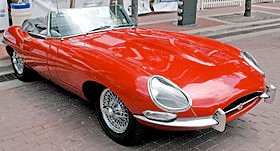 |
|
| Production | 1961–1968 |
|---|---|
| Body style | 2-door coupe 2-door 2+2 coupe 2-door convertible |
| Engine | 3.8 L XK I6 4.2 L XK I6 |
| Transmission | 4-speed manual; 3-speed automatic (automatic available 1966-onward, 2+2 model only) |
| Wheelbase | 96.0 in (2,438 mm) (FHC / OTS) 105.0 in (2,667 mm) (2+2) |
| Length | 175.3125 in (4,453 mm) (FHC / OTS) 184.4375 in (4,685 mm) (2+2) |
| Width | 65.25 in (1,657 mm) (all) |
| Height | 48.125 in (1,222 mm) (FHC) 50.125 in (1,273 mm) (2+2) 46.5 in (1,181 mm) (OTS) |
| Kerb weight | 2,900 lb (1,315 kg) (FHC) 2,770 lb (1,256 kg) (OTS) 3,090 lb (1,402 kg) (2+2) |
The Series 1 was introduced, initially for export only, in March 1961. The domestic market launch came four months later in July 1961. The cars at this time used the triple SU carburetted 3.8 litre six-cylinder Jaguar XK6 engine from the XK150S. Earlier built cars utilised external bonnet latches which required a tool to open and had a flat floor design. These cars are rare and more valuable. After that, the floors were dished to provide more leg room and the twin hood latches moved to inside the car. The 3.8-litre engine was increased to 4.2 litres in October 1964.
The 4.2-litre engine produced the same power as the 3.8-litre (265 bhp;198 kW) and same top speed (150 mph;240 km/h0), but increased torque from 240 to 283 lb·ft (330 to 384 N·m). Acceleration remained pretty much the same and 0 to 60 mph (0 to 97 km/h) times were around 7.0 seconds for both engines, but maximum power was now reached at 5,400rpm instead of 5,500rpm on the 3.8-litre. That all meant better throttle response for drivers that did not want to shift down gears.
All E-Types featured independent coil spring rear suspension with torsion bar front ends, and four wheel disc brakes, in-board at the rear, all were power-assisted. Jaguar was one of the first vehicle manufacturers to equip cars with disc brakes as standard from the XK150 in 1958. The Series 1 can be recognised by glass-covered headlights (up to 1967), small "mouth" opening at the front, signal lights and tail-lights above bumpers and exhaust tips under the number plate in the rear.
3.8-litre cars have leather-upholstered bucket seats, an aluminium-trimmed centre instrument panel and console (changed to vinyl and leather in 1963), and a Moss four-speed gearbox that lacks synchromesh for first gear ("Moss box"). 4.2-litre cars have more comfortable seats, improved brakes and electrical systems, and an all-synchromesh four-speed gearbox. 4.2-litre cars also have a badge on the boot proclaiming "Jaguar 4.2 Litre E-Type" (3.8 cars have a simple "Jaguar" badge). Optional extras included chrome spoked wheels and a detachable hard top for the OTS. When leaving the factory the car originally fitted Dunlop 6.40 × 15 inch RS5 tyres on 15 × 5K wire wheels (with the rear fitting 15 × 5K½ wheels suupplied with racing tyres). However the 4.2 Fixed-head Coupé fitted Dunlop 6.40 × 16 RS5 tyres and the 4.2 2 + 2 Automatic fitting SP41 185 − 15 tyres.
A 2+2 version of the coupé was added in 1966. The 2+2 offered the option of an automatic transmission. The body is 9 in (229 mm) longer and the roof angles are different. The roadster remained a strict two-seater.
Less widely known, right at the end of Series 1 production and prior to the transitional "Series 1½" referred to below, a very small number of Series 1 cars were produced with open headlights. Production dates on these machines vary but in right hand drive form production has been verified as late as March 1968. The low number of these cars produced make them amongst the rarest of all production E Types.
Following the Series 1 there was a transitional series of cars built in 1967–1968, unofficially called "Series 1½", which are externally similar to Series 1 cars. Due to American pressure the new features were open headlights, different switches, and some de-tuning (using two Zenith-Stromberg carburetters instead of the original three SUs) for US models. Some Series 1½ cars also have twin cooling fans and adjustable seat backs. Series 2 features were gradually introduced into the Series 1, creating the unofficial Series 1½ cars, but always with the Series 1 body style. A United States federal safety law affecting 1968 model year cars sold in the U.S. was the reason for the lack of headlight covers and change in switch design in the "Series 1.5" of 1968. An often overlooked change, one that is often "modified back" to the older style, is the wheel knock-off "nut." U.S. safety law for 1968 models also forbid the winged-spinner knockoff, and any 1968 model year sold in the U.S. should have a hexagonal knockoff nut, to be hammered on and off with the assistance of a special "socket" included with the car from the factory. This hexagonal nut carried on into the later Series 2 and 3.
An open 3.8-litre car, actually the first such production car to be completed, was tested by the British magazine The Motor in 1961 and had a top speed of 149.1 mph (240.0 km/h) and could accelerate from 0 to 60 mph (0 to 97 km/h) in 7.1 seconds. A fuel consumption of 21.3 miles per imperial gallon (13.3 L/100 km; 17.7 mpg-US) was recorded. The test car cost £2,097 including taxes.
Jaguar E Type 3.8 PERFORMANCE:
- FUEL CONSUMPTION: 19.0 miles, Imp gal, 15.8 miles 14.9 US gal
- MAX SPEED: 150 mph, 241.5 km h
- max speed in 1st gear: 42.2 mph, 68 km/h
- max speed in 2nd gear: 77.6 mph, 125 km/h
- max speed in 3rd gear: 116.2 mph, 187 km/h
max speed in 4th gear: 150 mph, 241.5 km/h - power-weight ratio: 9.5 lb/hp, 4.3 kg/hp
- useful load: 441 1b, 200 kg
- acceleration standing 1/4 mile 14.7 sec, 0—50 mph (0 —80 km/h) 5.6 sec
The cars submitted for road test by the popular motoring journals of the time (1961)such as The Motor, The Autocar and Autosport magazines were specially prepared by the Jaguar works to give better-than-standard performance figures. This work entailed engine balancing and subtle work such as gas-flowing the cylinder heads and may even have involved fitting larger diameter inlet valves.
Both of the well-known 1961 road test cars: the E-type Coupe Reg. No. 9600 HP and E-type Convertible Reg.No. 77 RW, were fitted with Dunlop Racing Tyres on test, which had a larger rolling diameter and lower drag co-efficient. This goes some way to explaining the 150 mph (240 km/h) maximum speeds that were obtained under ideal test conditions. The maximum safe rev limit for standard 6-cylinder 3.8-litre E-type engines is 5,500 rpm.
The later 4.2-Litre units had a red marking on the rev counter from just 5,000 rpm. The maximum safe engine speed is therefore 127mph (3.31:1 axle) and 137mph (3.07:1 axle) at the 5,500 rpm limit. Both test cars must have reached or exceeded 6,000 rpm in top gear when on road test in 1961.
PERFORMANCE ENGINE CAPACITY 4.2L
Engine Capacity 4.2L
Fuel Consumption 18.8 m/imp gal, 15.7 m/US gal, 15 1 x 100 km
Max Speed 153 mph, 246.3 km/h
max power (DIN): 265 hp at 5,400 rpm
max torque (DIN): 283 1b ft, 39.1 kg m at 4,000 rpm
max number of engine rpm: 6,000
specific power: 62.6 hp/l
standing 1/4 mile 15 sec, 0—50 mph (0 —80 km/h) 5.3 sec
speed in direct drive at 1,000 rpm: 24.7 mph, 39.8 km/h.
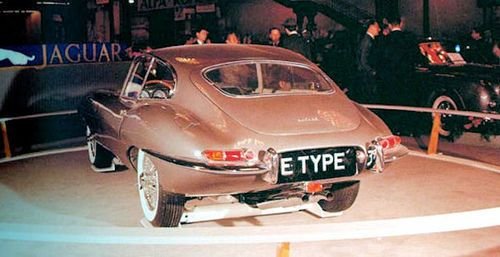
Concept versions
E1A (1957)
After the company's success at the Le Mans 24 hr through the 1950s, Jaguar's defunct racing department was given the brief to use D-Type style construction to build a road-going sports car, replacing the XK150.
The first prototype (E1A) featured a monocoque design, Jaguar's fully independent rear suspension and the well proved "XK" engine. The car was used solely for factory testing and was never formally released to the public. The car was eventually scrapped by the factory.
E2A (1960)
Jaguar's second E-Type concept was E2A which, unlike the E1A, was constructed from a steel chassis with an aluminium body. This car was completed as a racing car as it was thought by Jaguar at the time it would provide a better testing ground. E2A used a 3-litre version of the XK engine with a Lucas fuel injection system.
After retiring from the Le Mans 24 hr the car was shipped to America to be used for racing by Jaguar privateer Briggs Cunningham. In 1961, the car returned to Jaguar in England to be used as a test vehicle. Ownership of E2A passed to Roger Woodley (Jaguar's customer competition car manager) who took possession on the basis the car not be used for racing. E2A had been scheduled to be scrapped. Roger's wife Penny Griffiths owned E2A until 2008 when it was offered for sale at Bonham's Quail Auction. It eventually soldfor US$4,957,000.
Limited editions
Two limited production E-Type variants were made as test beds, the Low Drag Coupe and Lightweight E-Type, both of which were raced:
VARIATIONS AND OPTIONAL ACCESSORIES:
compression ratio 8: 1; ratios 2.93 - 3.07 - 3.54 •1; competition tyres 6.00 - 15 (front), 6.50 - 15 (rear).
Low Drag Coupé (1962)
Shortly after the introduction of the E-Type, Jaguar management wanted to investigate the possibility of building a car more in the spirit of the D-Type racer from which elements of the E-Type's styling and design were derived. One car was built to test the concept designed as a coupé as its monocoque design could only be made rigid enough for racing by using the "stressed skin" principle. Previous Jaguar racers were built as open-top cars, because they were based on ladder frame designs with independent chassis and bodies. Unlike the steel production E-Types, the LDC used lightweight aluminium. Malcolm Sayer retained the original tub with lighter outer panels riveted and glued to it. The front steel sub frame remained intact, the windshield was given a more pronounced slope, and the rear hatch was welded shut. Rear brake cooling ducts appeared next to the rear windows, and the interior trim was discarded, with only insulation around the transmission tunnel. With the exception of the windscreen, all cockpit glass was perspex. A tuned version of Jaguar's 3.8-litre engine with a wide-angle cylinder head design tested on the D-Type racers was used. Air management became a problem and, though a higher performing vehicle than its production counterpart, the car was never competitive.
The only test bed car was completed in summer of 1962 but was sold a year later to Jaguar racing driver Dick Protheroe. Since then it has passed through the hands of several collectors on both sides of the Atlantic and is now believed to reside in the private collection of the current Viscount Cowdray.
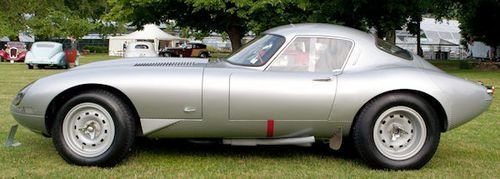
Lightweight E-Type (1963–1964)
Twelve cars plus two spare bodies were made by Jaguar.
In some ways, this was an evolution of the Low Drag Coupé. It made extensive use of aluminium alloy in the body panels and other components. However, with at least one exception, it remained an open-top car in the spirit of the D-Type to which this car is a more direct successor than the production E-Type which is more of a GT than a sports car. The cars used an aluminium block tuned version of the production 3.8-litre Jaguar engine with 300 bhp (224 kW) output rather than the 265 bhp (198 kW) produced by the "ordinary" version. All factory-built lightweights are fitted with Lucas Fuel Injection and a ZF 5 speed gearbox.
The cars were entered in various races but, unlike the C-Type and D-Type racing cars, they did not win at Le Mans or Sebring but were reasonably successful in private hands and in smaller races.
1961 Jaguar E-Type in Austin Powers: International Man of Mystery, Film 1997
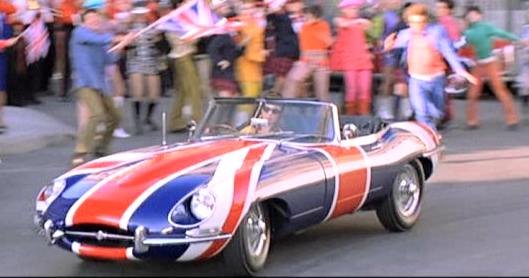
1961 Jaguar E Type in The Italian Job Movie from 1969
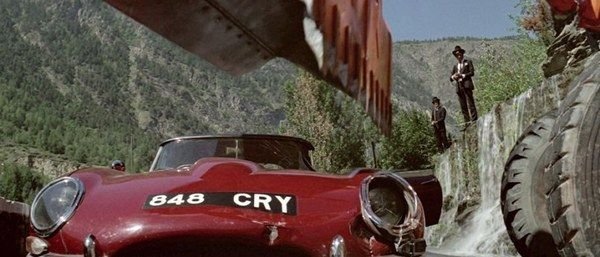
1961 Jaguar E-Type in The Avengers, TV Series, from the 1960s
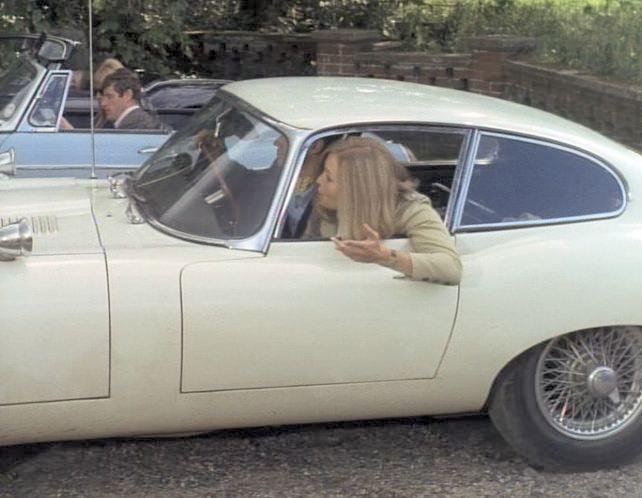
Technical
-
Jaguar E Type 3.8 Series 1 technical details and specifications
ENGINE 3.8-litre
Position front 4 stroke
cylinders: 6, vertical, in line
bore and stroke.3.42 x 4.17 in, 86.9 x 105.9 mm
engine capacity: 231.25 cu in, 3781 cu cm
compression ratio: 9 : 1
max power (SAE): 265 hp at 5500 rpm
max torque (SAE): 260 1b ft, 35.9 kgm at 4000 rpm
max number of engine rpm: 6000
specific power: 70.3 hp/l
cylinder block: cast iron, dry liners
cylinder head: light alloy, hemispherical combustion chambers
crankshaft bearings: 7
valves: 2 per cylinder, overhead, Vee-slanted at 70 °
thimble tappets
camshaft: 2, overhead
lubrication: gear pump, full flow filter
lubricating system capacity: 6.5 imp qt, 7.8 US qt 7.4 1
carburation: 3 SCI type HD carburettors
fuel feed: electric pumpENGINE 4.2-litre
front, 4 stroke
cylinders: 6. vertical, in line
bore and stroke: 3.62 x 4.17 in,
cylinder block: cast iron, dry liners
cylinder head: light alloy, hemispherical combustion chambers
crankshaft bearings: 7
valves: 2 per cylinder, overhead, Vee-slanted at 70°, thimble tappets
camshafts: 2, overhead
lubrication: mechanical pump,
full flow filter
lubricating system capacity: 15.66 imp pt, 18.81 1-JS pt, 8.9 1
carburation: 3 SU type HD 8 carburettors
fuel feed: electric pump
cooling system: water
cooling system capacity: 22 imp pt, 26.42 US pt, 12.5 1.TRANSMISSION:
driving wheels: rear
clutch: single dry plate, hydraulically controlled
gear box: mechanical
gears: 4 + reverse
synchromesh gears: II,III,IV
gear box ratios: (l) 3.378, (II) 1.861, (III) 1.284, (IV) 1, (Rev) 3.378
gear lever location: central
limited slip final drive: hypoid bevel ratio: 3.31CHASSIS:
integral, front tubular frame
front suspension: independent, wishbones, longitudinal torsion bars, anti-roll bar, telescopic dampers
rear suspension: independent, wishbones, semi-axle as upper arm, longitudinal trailing lower radius arms, anti roll bar, 4 coil springs, 4 telescopic dampers.
STEERING:
rack-and-pinion; turns of steering wheel lock to lock: 2.5.
BRAKES:
disc, separate front and rear circuits, servo.
ELECTRICAL EQUIPMENT:
voltage: 12 V; battery: 57 Ah
ignition distributor: Lucas
headlights: 2 front and reversing.
DIMENSIONS AND WEIGHT:
wheel base: 96.00 in, 2438 mm
front track: 50.00 in, 1270 mm
rear track: 50.00 in, 1270 mm
overall length: 175.31 in, 4453 mm
overall width: 65.25 in, 1657 mm
overall height: 48.00 in, 1219 mm
ground clearance: 5.50 in, 140 mm
dry weight: 2520 1b, 1143 kg
distribution of weight: 49.6 % front axle, 50.4 % rear axle
turning radius (between walls): 19.7 ft, 6 m© Motor car History
Service
-
Jaguar E Type SERVICE INSTRUCTIONS: Series 1
ENGINE CAPACITY 3.8L
fuel: petrol, 95-100 Oct
fuel tank capacity: 14.00 imp gal, 16.90 US gal, 64 1.
tyres: 6.40-15
cooling system capacity: 11.0 imp qt, 13.2 US qt, 12.5 1.
engine oil: 5.4 imp qt 6.5 US qt, 6.2 1, SAE 20 (winter) 30 (summer), change every 2500 miles, 4000 km
gearbox oil: 2.5 imp qt, 3.0 US qt, 2.8 1, SAE 30, change every 10000. miles, 16100 km
final drive oil: 2.7 imp qt, 3.3 US qt. 3.1 1, SAE 90, change every 10000 miles, 16100 km
greasing: every 2500 miles, 4000 km, 22 points
tappet clearances: inlet 0.004 in, 0.10 mm, exhaust 0.006 in, 0.15 mm;
valve timing: (inlet) opens 15° before tdc and closes 57° after bdc, (exhaust) opens 57° before bdc and closes 15° after tdc
tyre pressure '(medium load): front 30 psi, 2.1 atm, rear 35 psi, 2.5 atm.ENGINE CAPACITY 4.2L
engine oil: 14.96 imp pt, 17.97 US pt, 8.5 1, SAE 20 (winter) 30 (summer), change every 2,500 miles, 4,000 km
tappet clearances: inlet 0.004 in, 0.10 mm, exhaust 0.006 in, 0.15 mm
valve timing: inlet opens 15° before tdc and closes 57° after bdc, exhaust opens 57° before bdc and closes 15° after tdc© Motor car History
